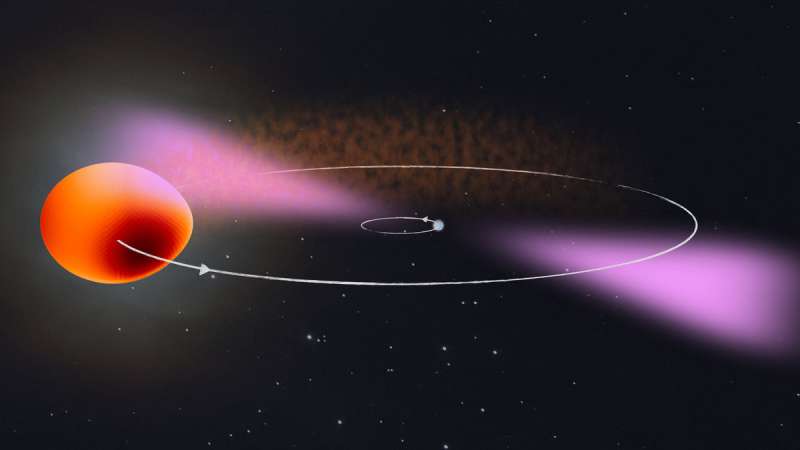An international research team including members from the Max Planck Institute for Gravitational Physics (Albert Einstein Institute; AEI) in Hannover has shown that a rapidly rotating neutron star is at the core of a celestial object now known as PSR J2039−5617. They used novel data analysis methods and the enormous computing power of the citizen science project Einstein@Home to track down the neutron star's faint gamma-ray pulsations in data from NASA's Fermi Space Telescope. Their results show that the pulsar is in orbit with a stellar companion about a sixth of the mass of our Sun. The pulsar is slowly but surely evaporating this star. The team also found that the companion's orbit varies slightly and unpredictably over time. Using their search method, they expect to find more such systems with Einstein@Home in the future.
"It had been suspected for years that there is a pulsar, a rapidly rotating neutron star, at the heart of the source we now know as PSR J2039−5617," says Lars Nieder, a Ph.D. student at the Max Planck Institute for Gravitational Physics (Albert Einstein Institute; AEI) in Hannover and co-author of the study published today in Monthly Notices of the Royal Astronomical Society. "But it was only possible to lift the veil and discover the gamma-ray pulsations with the computing power donated by tens of thousands of volunteers to Einstein@Home," he adds.
The celestial object has been known since 2014 as a source of X-rays, gamma rays, and light. All evidence obtained so far pointed at a rapidly rotating neutron star in orbit with a light-weight star being at the heart of the source. But clear proof was missing.
Precision observations with optical telescopes
The first step to solving this riddle were new observations of the stellar companion with optical telescopes. They provided precise knowledge about the binary system without which a gamma-ray pulsar search (even with Einstein@Home's huge computing power) would be unfeasible.
The system's brightness varies during an orbital period depending on which side of the neutron star's companion is facing the Earth. "For J2039-5617, there are two main processes at work," explains Dr. Colin Clark from Jodrell Bank Centre for Astrophysics, lead author of the study and former Ph.D. student at AEI Hannover. "The pulsar heats up one side of the light-weight companion, which appears brighter and more bluish. Additionally, the companion is distorted by the pulsar's gravitational pull causing the apparent size of the star to vary over the orbit." These observations allowed the team to get the most precise measurement possible of the binary star's 5.5-hour orbital period, as well as other properties of the system.
Searching with the help of tens of thousands of volunteers
With this information and the precise sky position from Gaia data, the team used the aggregated computing power of the distributed volunteer computing project Einstein@Home for a new search of about 11 years of archival observations of NASA's Fermi Gamma-ray Space Telescope. Improving on earlier methods they had developed for this purpose, they enlisted the help of tens of thousands of volunteers to search Fermi data for periodic pulsations in the gamma-ray photons registered by the Large Area Telescope onboard the space telescope. The volunteers donated idle compute cycles on their computers' CPUs and GPUs to Einstein@Home.
This search required combing very finely through the data in order not to miss any possible signals. The computing power required is enormous. The search would have taken 500 years to complete on a single computer core. By using a part of the Einstein@Home resources it was done in 2 months.
With the computing power donated by the Einstein@Home volunteers, the team discovered gamma-ray pulsations from the rapidly rotating neutron star. This gamma-ray pulsar, now known as J2039−5617, rotates about 377 times each second.
Surprising changes of the orbit
"We found that the companion's orbital period varies slightly and unpredictably over the 11 years. It only changes by up to about ten milliseconds, but since we know the arrival time of every single gamma photon from the pulsar to microsecond precision, even this little is a lot!" says Nieder. These variations of the orbital period could be linked to tiny changes in the shape of the companion caused by its magnetic activity. Similar to our Sun the companion might be going through activity cycles. The changing magnetic field interacts with the plasma inside the star and deforms it. As the shape of the star varies its gravitational field also changes, which in turn affects the pulsar orbit. This could explain the observed orbital period variations.
"Spidery" pulsars consume their mates
While the light-weight stellar companion is orbiting the pulsar, the strong radiation and particle wind from the pulsar evaporate the companion. "This is the reason that astronomers call systems like this one 'redbacks' in reference to the Australian redback spiders whose females consume the males after mating," explains Nieder. In the case of J2039−5617 the matter ablated from the star forms clouds of charged particles in the binary system that absorb radio waves. This is one of the reasons that previous searches for pulsating radio emission from the neutron star failed. With the precise determination of the orbit from the gamma-ray data, it was also possible to detect radio pulsations and this will be published in a separate paper.
"We know dozens of similar gamma-ray sources found by the Fermi Space Telescope, for which the true identity is still unclear," says Prof. Dr. Bruce Allen, director at the Max Planck Institute for Gravitational Physics in Hannover and director and founder of Einstein@Home. "Many might be pulsars hidden in binary systems and we will continue to chase after them with Einstein@Home," he adds.
Explore further
A Corongiu et al. Radio pulsations from the γ-ray millisecond pulsar PSR J2039−5617, Monthly Notices of the Royal Astronomical Society (2020). DOI: 10.1093/mnras/staa3463



